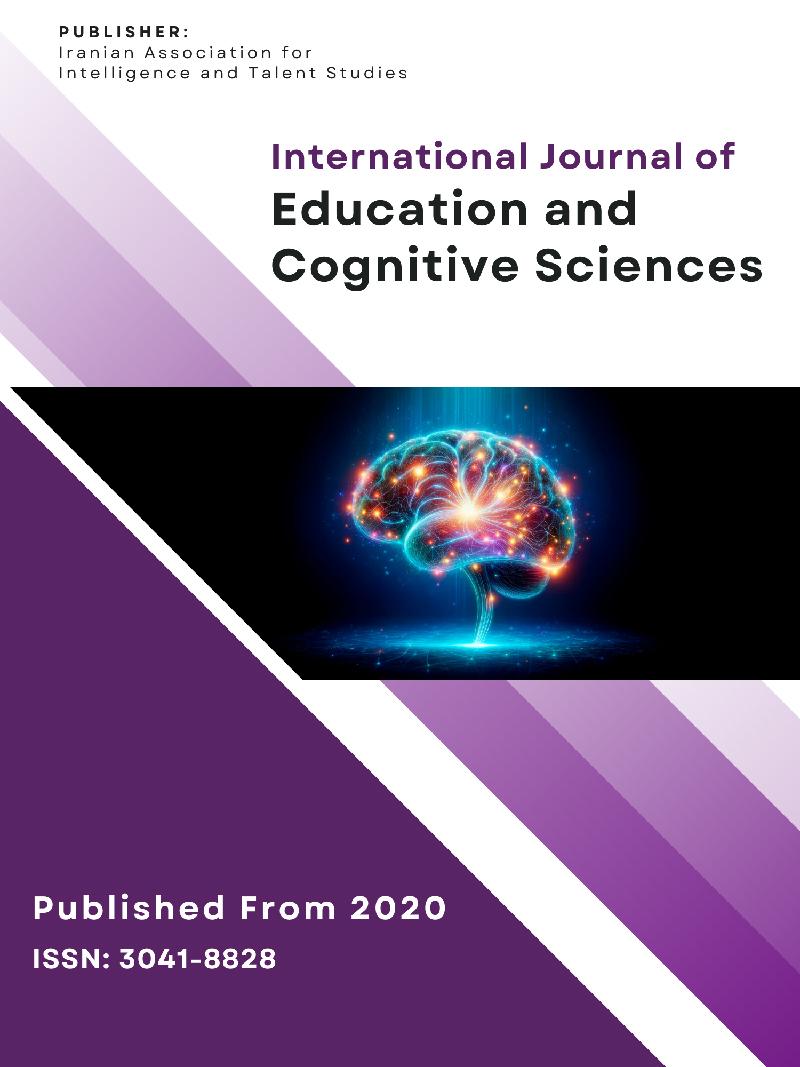A Comparative Study of Perceived Parenting Styles, Anxiety Sensitivity, and Ego Strength in Female Victims of Domestic Violence Seeking Divorce, With and Without Generalized Anxiety Disorder
Keywords:
generalized anxiety disorder, domestic violence, parenting styles, anxiety sensitivity, ego strength, divorceAbstract
Purpose: This causal-comparative study compared perceived parenting styles (parental warmth and autonomy support), anxiety sensitivity, and ego strength among female victims of domestic violence seeking divorce, differentiating between those with and without generalized anxiety disorder (GAD).
Methods and Materials: The sample included 80 women (40 with GAD, 40 without GAD) from Qom Province, Iran, selected via convenience sampling in 2024-2025. Participants were screened using the Structured Clinical Interview for DSM-5 Disorders (SCID-5-RV) and completed the Grolnick Perceived Parenting Scale, the Taylor & Cox Anxiety Sensitivity Index, and the Markstrom Ego Strength Scale. Data were analyzed using Multivariate Analysis of Variance (MANOVA).
Findings: MANOVA revealed a significant overall difference between the two groups (Pillai’s Trace = .88, p <.001, η² = .88). The non-GAD group reported significantly higher levels of parental warmth (p <.001), parental autonomy support (p <.001), and ego strength (p <.001). Conversely, the GAD group exhibited significantly higher anxiety sensitivity (p <.001).
Conclusion: The findings indicate that a lack of parental warmth and autonomy during development, coupled with high anxiety sensitivity and low ego strength, is strongly associated with GAD in women experiencing the dual trauma of domestic violence and divorce. Interventions should focus on restructuring maladaptive cognitive schemas, enhancing emotion regulation, and building ego strength.
Downloads
References
Baumrind, D. (1967). Child care practices anteceding three patterns of preschool behavior. Genetic Psychology Monographs, 75(1), 43–88. https://img3.reoveme.com/m/8fea8f4067e8196d.pdf
Besharat, M. A. (2015). Development and validation of the Ego Strength Scale (ESS). Contemporary psychology, 10(1), 3–12. https://psychologicalscience.ir/browse.php?a_id=163&sid=1&slc_lang=en
Bilsky, S. A., Feldner, M. T., Knapp, A. A., Rojas, S. M., & Leen-Feldner, E. W. (2020). The role of anxiety sensitivity in the association between childhood maltreatment and anxiety and depression: A prospective investigation. Journal of anxiety disorders, 69, 102172. https://doi.org/10.1016/j.janxdis.2019.102172
Biracyaza, E. (2019). Anxiety sensitivity and its impact on the development of anxiety disorders: A systematic review. Journal of Affective Disorders Reports, 1, 100004. https://doi.org/10.1016/j.jadr.2019.100004
Bowlby, J. (1982). Attachment and loss: Vol. 1. Attachment. Basic Books.
Chauhan, S., & Dutt, A. (2023). Parenting styles and their impact on adult psychopathology: A meta-analytic review. Clinical psychology review, 99, 102235. https://doi.org/10.1016/j.cpr.2022.102235
Dadastan, A. (2017). On Freud's theory of anxiety. Roshd Press.
Deci, E. L., & Ryan, R. M. (2017). Self-determination theory: Basic psychological needs in motivation, development, and wellness. Guilford Press. https://psycnet.apa.org/record/2017-04680-000
First, M. B., Williams, J. B. W., Karg, R. S., & Spitzer, R. L. (2015). Structured Clinical Interview for DSM-5 Disorders—Research Version (SCID-5-RV). American Psychiatric Association Publishing. https://apsychoserver.psychofizz.psych.arizona.edu/JJBAReprints/PSYC621/694A/SCID/SCID-5-CV.pdf
Fonagy, P., Luyten, P., & Allison, E. (2016). The role of mentalizing and epistemic trust in the therapeutic relationship. Psychotherapy, 53(3), 372–380. https://doi.org/10.1037/pst0000065
Freud, S. (1961). The ego and the id. The Standard Edition of the Complete Psychological Works of Sigmund Freud, 19, 12–66.
Grolnick, W. S., Deci, E. L., & Ryan, R. M. (1997). Internalization within the family: The self-determination theory perspective. In J. E. Grusec & L. Kuczynski (Eds.), Parenting and children's internalization of values: A handbook of contemporary theory (pp. 135–161). John Wiley & Sons. https://selfdeterminationtheory.org/wp-content/uploads/2020/10/1997_GrolnickDeciRyan.pdf
Hegarty, K., McKibbin, G., Hameed, M., Koziol-McLain, J., Feder, G., Tarzia, L., & Hooker, L. (2023). The health impacts of intimate partner violence against women: A life course perspective. The Lancet Public Health, 8(4), e299–e310. https://doi.org/10.1016/S2468-2667(23)00018-3
Li, D., Li, W., Lin, X., & Zhu, X. (2025). Associations Between Overprotective Parenting Style and Academic Anxiety Among Chinese High School Students. BMC psychology, 13(1). https://doi.org/10.1186/s40359-025-02455-z
Lisi, A., Lanna, M., & Maldonado, R. (2023). The longitudinal association between intimate partner violence and incidence of anxiety disorders in women: A population-based study. Journal of affective disorders, 320, 221–228. https://doi.org/10.1016/j.jad.2022.09.104
Markstrom, C. A., Marshall, S. K., & Tryon, R. J. (1997). Ego strength and psychosocial development in adolescence. Journal of youth and adolescence, 26(5), 539–550. https://doi.org/10.1023/A:1024525726487
Mikulincer, M., & Shaver, P. R. (2016). Attachment in adulthood: Structure, dynamics, and change (2 ed.). Guilford Press. https://psycnet.apa.org/record/2007-12400-000
Millan, M. J. (2022). Agomelatine for the treatment of generalized anxiety disorder: Focus on its distinctive mechanism of action. Therapeutic Advances in Psychopharmacology, 12, 1–15. https://doi.org/10.1177/20451253221105128
Mirzaei, M., Yousefi, Z., & Baratali, M. (2025). Comparison of the effectiveness of anxiety management training related to university entrance exam children and acceptance and commitment training on parental adaptability, parenting orientation, and parental rumination among mothers of exam-bound children. Psychological Dynamics in Mood Disorders, 4(1), 18-35. https://doi.org/10.61838/kman.pdmd.4.1.2
Preti, A., Demontis, R., Cossu, G., Kalcev, G., Cabras, F., Moro, M. F., Romano, F., Balestrieri, M., Caraci, F., Dell'Osso, L., & Di Sciascio, G. (2021). The lifetime prevalence and impact of generalized anxiety disorders in an epidemiologic Italian national survey. BMC psychiatry, 21(1), 1–11. https://doi.org/10.1186/s12888-021-03042-3
Rogers, A. A., Padilla-Walker, L. M., McLean, R. D., & Hurst, J. L. (2020). Trajectories of perceived parental psychological control across adolescence and implications for the development of depressive and anxiety symptoms. Journal of youth and adolescence, 49(1), 136–149. https://doi.org/10.1007/s10964-019-01158-0
Siddiqui, M. I., Kazi, K. A., Qadri, J. A., Rajput, A. H., Pandhiani, H., & Memon, M. A. (2021). Tracing the roots of generalized anxiety disorder: Domestic violence and abuse. International Journal of Women's Empowerment, 7(1), 48–61. https://doi.org/10.29052/2413-4252.v7.i1.2021.6-10
Stein, M. B., & Sareen, J. (2020). Generalized anxiety disorder. New England Journal of Medicine, 373(21), 2059–2068. https://doi.org/10.1056/NEJMcp1808501
Straus, M. A., Hamby, S. L., Boney-McCoy, S., & Sugarman, D. B. (1996). The revised Conflict Tactics Scales (CTS2): Development and preliminary psychometric data. Journal of Family Issues, 17(3), 283–316. https://doi.org/10.1177/019251396017003001
Taylor, S., Zvolensky, M. J., Cox, B. J., Deacon, B., Heimberg, R. G., Ledley, D. R., & Cardenas, S. J. (2007). Robust dimensions of anxiety sensitivity: Development and initial validation of the Anxiety Sensitivity Index-3. Psychological assessment, 19(2), 176–188. https://doi.org/10.1037/1040-3590.19.2.176
Timpano, K. R., Carbonella, J. Y., Keough, M. E., Abramowitz, J., & Schmidt, N. B. (2015). Anxiety sensitivity: An examination of the relationship with authoritarian, authoritative, and permissive parental styles. Journal of Cognitive Psychotherapy, 29(2), 95–105. https://doi.org/10.1891/0889-8391.29.2.95
Vijay, C., Gonsalves, K. P., & Ramesh, N. (2022). Parenting styles and mental health of adolescents: A cross-sectional study in South India. Journal of Mental Health and Human Behaviour, 27(1), 19–23. https://doi.org/10.4103/jmhhb.jmhhb_176_20
World Health Organization. (2021). Violence against women prevalence estimates, 2018: Global, regional and national prevalence estimates for intimate partner violence against women and global and regional prevalence estimates for non-partner sexual violence against women. https://www.who.int/publications/i/item/9789240022256
Young, J. E., Klosko, J. S., & Weishaar, M. E. (2003). Schema therapy: A practitioner's guide. Guilford Press. https://psycnet.apa.org/record/2003-00629-000
Downloads
Published
Submitted
Revised
Accepted
Issue
Section
License
Copyright (c) 2025 Afnan Jafari (Author); Nasrin Goodarzi

This work is licensed under a Creative Commons Attribution-NonCommercial 4.0 International License.










